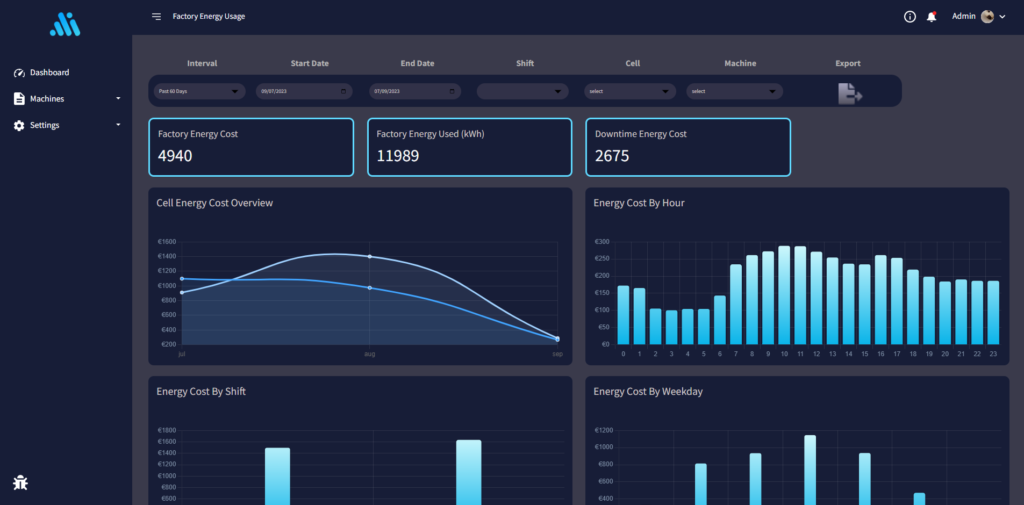Manufacturing products requires intense amounts of energy. And energy is expensive. Energy is the most volatile cost in manufacturing, making energy costs one of the greatest risks to manufacturers. Structuring your shop floor to maximise energy efficiency is the best way to manage the risk of energy cost volatility. On the upside, manufacturers can develop a competitive advantage through energy efficiency. Manufacturers should expect that energy challenges will continue to be the norm going forward and move towards an ethos of embracing this change. Manufacturers that start with a strong foundation in energy efficiency can continue to build on that advantage through vigilance of developments in energy efficiency technologies, best practices, and funding mechanisms.
Purpose of this Guide
This guide provides an overview of energy efficiency in manufacturing, aiming to provide readers with a basic understanding of the principles and how to navigate them. We outline a roadmap of options for optimising energy efficiency. Some energy-saving measures are free of cost, while others require capital. This allows for a crawl-walk-run approach to energy efficiency in manufacturing.
This guide will help you understand:
- Energy efficiency steps you can take without capital investment
- Low-hanging fruit: Where to look for high-impact energy savings
- Energy Management Systems: How to turn energy monitoring into cost savings
- Energy Audits: What they cover and how they proceed
- Government funding resources: What they are and where to find them
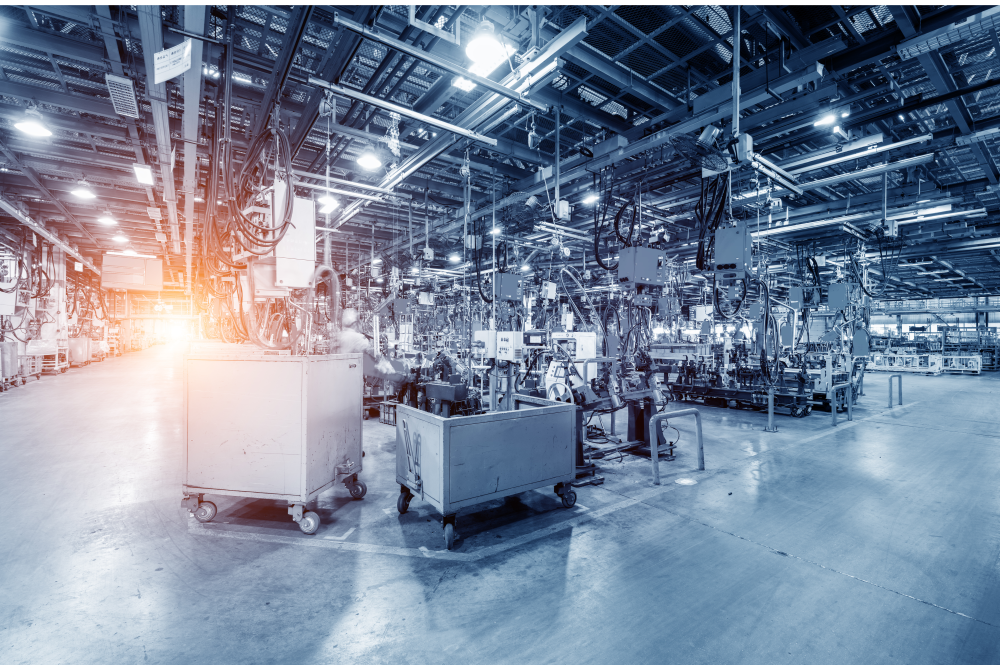
Energy Efficiency in Manufacturing: What You Can Do Without Capital Investment
Manufacturers are keen to find ways to reduce energy consumption, but not at the expense of profitability. Certainly, there are ways to balance both energy efficiency and profitability. However, the most significant energy efficiency gains will likely require up-front capital investment. Below we explore energy efficiency gains that can be realised without capital investment.
Optimising Scheduling
Altering the schedules for processes or machines can benefit those looking to maximise energy efficiency in manufacturing. As most idling machines can require 80% of energy loads drawn during full production, it’s easy to see how you can find efficiencies through scheduling optimisation.
Traditionally, manufacturers have sought to optimise for one of these three variables:
- Output: Utilise whatever levels of energy, machine efficiency or cost to maximise output
- Energy: Schedule for minimum energy input, regardless of production timelines
- Production Efficiency: Schedule for maximum use of all production assets
Cutting-edge research is carried out to find schedules that maintain production levels while minimising energy usage. Researchers apply advanced techniques like swarm intelligence and evolutionary algorithms to find optimal schedules. These highly mathematical techniques will be brought to the mainstream as they are proven out. For now, it’s enough to be aware that scheduling can have a significant impact on energy usage. If you have a way of tracking energy loads, for example via an Energy Management System, you can begin the process of including energy efficiency into production scheduling.
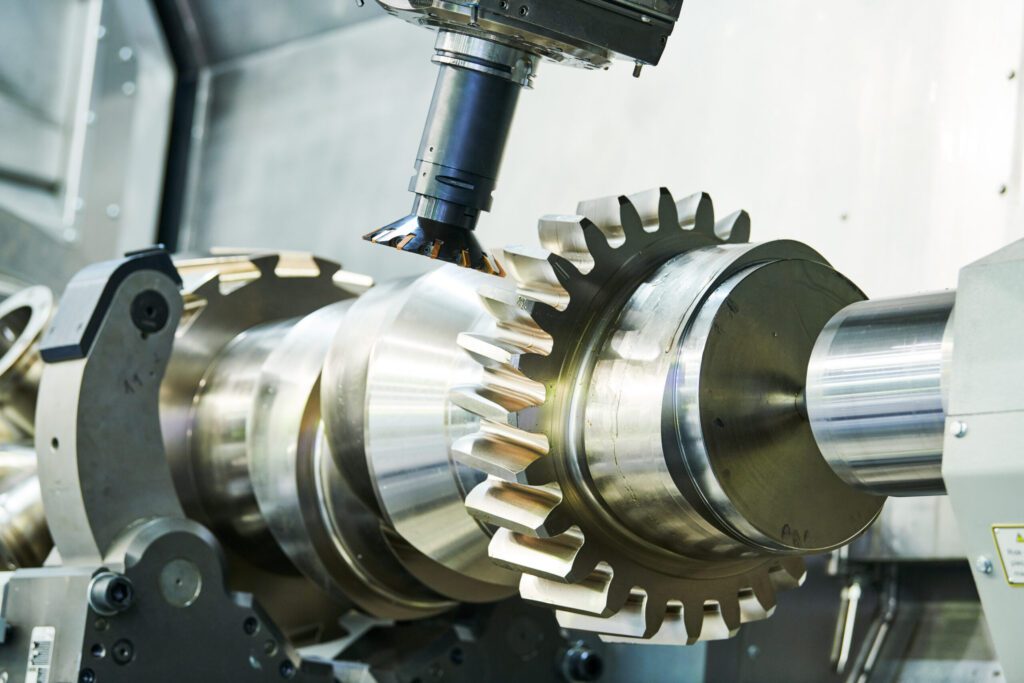
Equipment Maintenance
Machines on a shop floor begin to degrade the moment you put them into use. Maintenance is key to production at any facility. Proper maintenance of factory equipment can also lead to gains in energy efficiency for manufacturing.
In manufacturing there are three basic approaches to the maintenance of machines:
- Reactive
- Preventative
- Predictive
Reactive Maintenance is the least energy-efficient scheme, and Predictive Maintenance the most energy efficient. In practice, most shops use a mix of approaches.
Reactive Maintenance
Reactive maintenance is performed after a machine or process fails. Most shops would not choose reactive maintenance as their primary strategy, but many fall into it due to competing priorities. Reactive maintenance has the advantage of requiring the least amount of up-front investment. Of course, it has the downside of posing the greatest risk to productivity.

Preventative Maintenance
In Preventive Maintenance, technicians provide routine maintenance to the machines on a shop floor according to a pre-set schedule. Because of this, it’s also referred to as “time-based maintenance”. In time-based maintenance, maintenance occurs whether or not issues have arisen with the equipment. With preventative maintenance, you can reduce overall energy usage by 18% versus reactive maintenance. Reactive maintenance can require less up-front costs, in the form of planning and regular staff. In the long run, preventive maintenance increases production efficiency, protects staff, reduces downtime, and extends the lifespan of equipment.
Time-based maintenance will lead to energy efficiencies in the long run and is relatively easy to implement. However, time-based maintenance is not the optimal choice, as it requires broad application of maintenance activities, even when maintenance isn’t strictly necessary. Also, with time-based maintenance, a machine might perform inefficiently for weeks prior to a scheduled maintenance.
Predictive Maintenance
Predictive maintenance, or “conditions-based maintenance”, is a system of upkeep in which machines are proactively monitored for any changes to their condition. Technicians check for faults whenever machines are flagged for changes to their status quo. This way, machines undergo maintenance before issues turn into major problems. Machines on a shop floor are continuously monitored for conditions such as temperature, vibration, energy draw, humidity, and magnetic fields. Deviations in these conditions raise a signal in a centralised monitoring system. Sensors in conditions-based maintenance often make use of “Internet of Things” (IoT) technologies to monitor conditions in real-time. Conditions-based predictive maintenance requires more up-front costs, in the form of sensors and a centralised systems to monitor them.
Over the long run, conditions-based predictive maintenance can reduce overall costs by only deploying maintenance when it is absolutely necessary. Beyond energy savings, you can reduce downtime by 35-50% and increase machine lifespan by 20-40% through Predictive Maintenance.
Lean Manufacturing
Fundamentally, lean manufacturing is a methodology to continuously improve productivity, through focusing on eliminating waste and maximising value from operations. Organisations have discovered huge gains in productivity by implementing lean manufacturing techniques. Less well-known are the gains to energy efficiency that lean approaches can bring. Moving towards lean manufacturing can, in itself, lead to overall energy efficiencies. McKinsey cites an example of lean manufacturing leading to a 30% reduction in overall energy usage. A large portion of the gains realised can be attributed to the predictive maintenance measures associated with lean manufacturing (discussed above). However, predictive maintenance isn’t the only driver of energy efficiency. Lean manufacturing techniques such as theoretical minimums, loss-mapping, and statistical analysis can lead to further energy reductions.
Much has been written about lean manufacturing, and it is not our purpose to provide a guide to its benefits or applications in this article. Suffice it to say that implementation of lean manufacturing practices within your manufacturing operation can lead to substantial energy efficiencies, as well as gains in productivity and profitability.
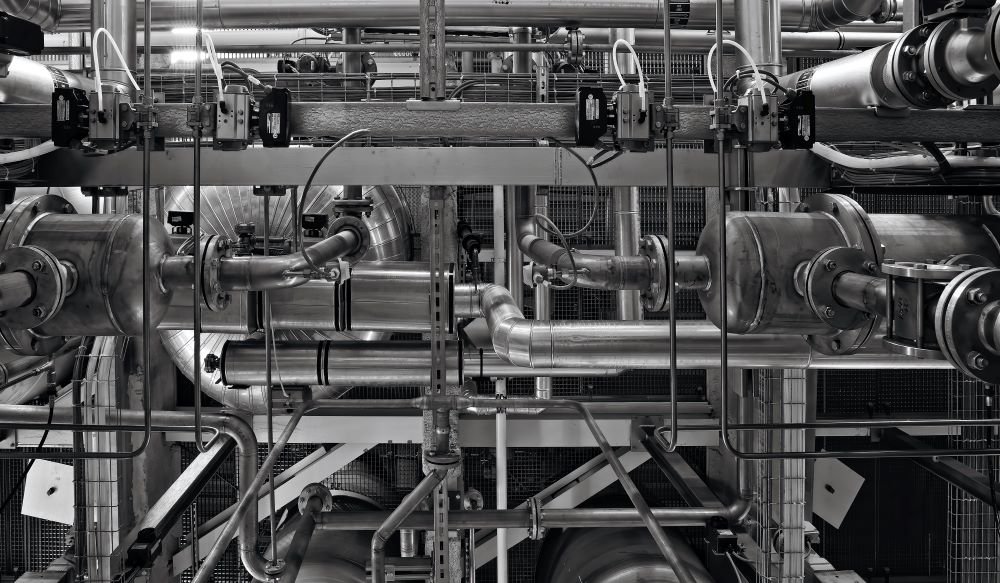
Low Hanging Fruit – Where to Look for Energy Efficiencies in Manufacturing
All factories are different, and all factories use energy in different ways. However, some well-known areas of manufacturing processes consume large amounts of energy. Within these processes lie many low-hanging fruits for energy efficiency in manufacturing. Realising energy efficiencies in these low-hanging fruit will likely require some capital investment – though in many cases this can be minimal.
Low-hanging Fruits for Energy Efficiency in manufacturing:
- Buildings
- Lighting
- Heating and Boilers
- HVAC Systems
Buildings
The buildings that house manufacturing operations can present huge opportunities for energy savings, depending on their age and condition. Building-related energy efficiencies typically involve heat regulation – heating, cooling, and ventilation. You can find efficiencies by ensuring that spaces are air-tight and well-insulated. Other places to look are in schedules for heating and cooling – ensuring that efforts to regulate heating closely follow schedules for building activity.
In Ireland, the SEAI handbook provides suggestions for finding building energy efficiency opportunities. You can find an even more comprehensive resource in CIBSE’s Guide F to Energy Efficiency in Buildings. For examples of low-hanging fruit to be found in your buildings see our post on How to Find Energy Efficiency in Manufacturing: Buildings
Lighting
Proper lighting is required in manufacturing operations to ensure safety and productivity. However, as lighting can represent up to 40% of a building’s electricity use, substantial savings can be found. The easiest way to enact large-scale energy efficiencies in lighting is to switch from traditional incandescent-bulb lighting to LED lights. By installing LED lighting, you can save 75% energy versus incandescent lighting. Another place that manufacturers can find energy savings from lighting is in the distribution of light within their operations. Efficient distribution of light involves ensuring that you’re using the right amount of light in the right places. Often this boils down to ensuring that light sources are in physical proximity to crucial operations. Increasing the length of hanging lights, to bring them closer to operations, can enable manufacturers to deploy lower-energy bulbs.
Finally, a very simple way to ensure adherence to light-saving policies is to locate lighting controls in easy-to-reach places. Controls for lighting should be near to the operators that are utilising the lighting. For a more comprehensive guide to lighting in manufacturing, consult the SEAI Energy Efficient LED Lighting Guide.

HVAC Systems
Heating, ventilation, and air conditioning (HVAC) systems are primarily concerned with keeping conditions comfortable and productive for human operators. HVAC systems account for around 15% of all energy use in manufacturing and are thus a primary candidate for efficiency opportunities. HVAC systems can be complex to implement and operate, involving heating systems, fans, refrigerant compressors, and circulation pumps. While it is generally advisable to address HVAC systems within the scope of a professional energy audit, there are a handful of pedestrian opportunities to look into.
Something as simple as setting the correct time and date can help your HVAC system ensure that it is optimising temperatures for occupancy levels. Maintaining lower temperatures in hallways or pass-through areas can result in energy savings. Restricting access to heating and cooling controls can also help to ensure that HVAC systems are operating at optimal levels. For a more comprehensive guide to HVAC energy efficiency opportunities, consult the SEAI Energy Audit Handbook.
Heating and Boilers
Oil and hot-water boiling systems are often used in manufacturing as sources for both space-heating and process-heating. Boilers are notorious culprits for energy inefficiencies. When looking to optimise energy efficiency in boilers, the three primary places to check are flue-gas exit temperatures, excess air in the system, and burnout. Of course, you can gain substantial efficiencies by replacing an inefficient boiler. Condensing boilers are much more efficient at converting fuel to heat, and this efficiency can lead to 25% savings in energy costs to run the boiler.
Renewable Energy in Manufacturing
Using renewable energy does not, in itself, help a manufacturer reduce energy usage. Instead, the use of renewable energy in manufacturing can help reduce a factory’s carbon footprint and can increase a manufacturer’s energy resilience. Energy resilience is the degree to which an organisation can maintain operations through energy shocks. Manufacturers can increase their energy resilience by diversifying their sources of energy. Sourcing some of their power from renewables can help manufacturers maintain operations even when difficulties with traditional energy sources arise.
Governments often provide grants and incentives to help manufacturers minimise their carbon footprint and increase energy resilience. For example, in Ireland, manufacturers obtain government grants to fund the development of solar energy generation projects. But most government schemes for renewable energy focus on getting manufacturers to switch sources of energy, rather than reduce consumption thereof.
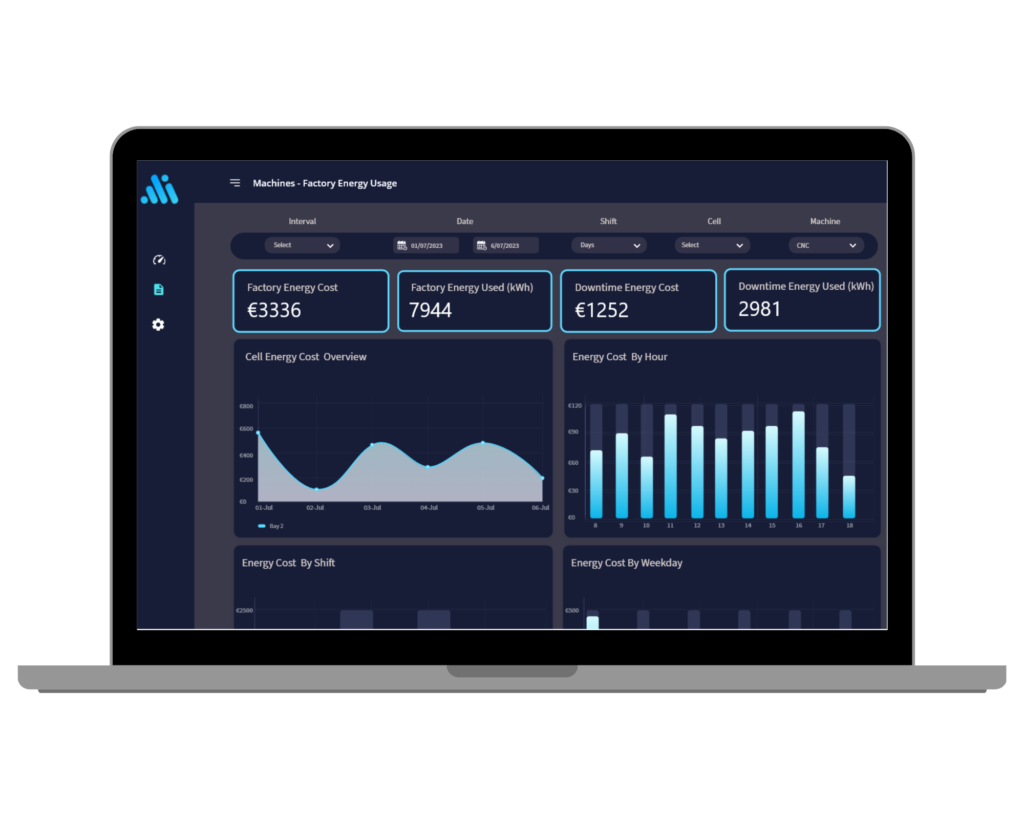
Energy Management Systems
Central to any effort to increase energy efficiency is having a system for monitoring and measuring energy usage. In this section, we will discuss Energy Management Systems. An Energy Management System (sometimes abbreviated to “EMS” or “BEMS” for Building Energy Management System) is a set of tools that allow manufacturers to monitor, measure, analyse & control the consumption of energy within their machines, processes, or across the entirety of their site. Energy Management Systems require an up-front cost but enable manufacturers to discover and prioritise energy efficiency opportunities themselves.
This section will help you understand:
- Energy Analytics, KPIs, and Metrics
- Technologies in Energy Management Systems
- How to Drive Savings and Profits through Usage of an EMS
Energy Analytics: KPIs & Metrics
If you want to find ways to consistently and predictably reduce your energy consumption, first you must measure the energy you use. However, there are several different ways to approach measuring energy usage. To communicate effectively with your staff, and to evaluate different Energy Management Systems, you’ll want to familiarise yourself with some of these different metrics for energy monitoring.
- Energy Efficiency: The total amount of energy used to another metric, such as production output
- Specific energy consumption: The amount of energy required to create a single unit of output
- Unproductive Downtime Energy Use: The energy used by assets when in an unproductive state
- Machine Power Differences: The high and low energy-usage parameters between which a machine operates under normal conditions
For a deeper dive into energy KPIs and energy analytics, see the Guide to Energy Management Systems.

Technologies in Energy Management Systems
Different providers solve the riddle of measuring energy usage in different ways.
Energy Management Systems differ in these main ways:
- Direct Measurement vs. Non-Invasive
- The granularity to which energy is measured
- Technologies used to provide energy usage prediction estimates
Direct Measurement vs. Non-Invasive
Direct measurement EMS solutions are directly wired into electrical cabinets and into machines. Non-invasive EMS solutions leverage technical solutions that enable them to provide energy measurements that are just as reliable and accurate but don’t require the disruption of prefabricated electrical components in cabinets or machines. An additional benefit of non-invasive EMS solutions is that they are generally much faster to implement and are not disruptive to manufacturing production processes. For more on energy monitoring approaches and technologies, see the Guide to Energy Management Systems.
The Granularity of Measurement in Energy Management Systems
Another axis on which EMS solutions differ is the granularity to which they are able to provide measurements. The most basic EMS systems only measure the total electricity consumption of the entire manufacturing facility. Mavarick’s EMS solutions are able to measure electricity usage at the building-level, cell-level, machine-level and even at the sub-asset level (energy usage within a single machine, for different machine processes). For a deeper look at EMS, see the Guide to Energy Management Systems.
Technologies Used to Provide Energy Usage Prediction Estimates
Energy Management Systems are used not only to measure energy usage after the fact, but also to predict energy levels required to power different manufacturing outputs. The most advanced EMS solutions make use of Internet of Things (IoT) and Artificial Intelligence (AI) to generate predictive capacity needs. Mavarick’s EMS solution, which pairs IoT and AI with the most granular energy monitoring available, provides unsurpassed accuracy for predicting energy needs. See the Guide to Energy Management Systems for more on technologies & approaches used in EMS.
Energy Analytics: Turning Energy Insights into Cost Savings
The goal of saving the planet is noble (and necessary). However, most manufacturers are more immediately concerned with saving costs. If you’re looking to save costs through energy management, ultimately you need to turn energy insights into cost savings. See below for examples of how to turn energy insights into cost savings.
Here are some of the ways that manufacturers leverage their EMS to reduce costs:
- Reduce Downtime Energy Costs: Identify periods when machines are running idle or at reduced capacity
- Shift Loads: Run the most energy-intensive processes at off-peak times
- Predictive Maintenance: Use energy draw as an indicator for when machines require maintenance
- Minimising Total Energy Overhead: Use EMS to establish benchmarks to ensure that energy usage is within parameters.
Energy Management Systems can also be used to help you win more manufacturing business. An EMS can help you make more accurate energy usage predictions. More accurate energy usage predictions can help you make more competitive (lower) pricing proposals, as you don’t need to pad your pricing as much to allow for energy volatility costs. For a deeper dive see How to Use an Energy Management System to Drive Savings & Profits.

Energy Management Systems and ISO 50001
The International Organisation for Standardisation (ISO) is a global organisation that maintains best practice standards for business and industry. ISO 50001 is a standard that pertains to best practices for energy management systems.
Implementing ISO 50001 will help you:
- Develop effective policy and get commitment across the organisation, including executives
- Understand the current state of energy usage, and use these to develop business-specific KPIs
- Establish targets and a plan for achieving energy efficiency
- Implement change as outlined in the plan
- Monitor progress against targets
- Continuously improve energy efficiency through ongoing initiatives
- Document the energy management system
- Integrate energy management through organisation-wide training & initiatives
- Maintain standards through regular updates and audits of the system
For more on ISO 50001 certification, see the SEAI website or the ISO Organisation website.
Manufacturing Energy Audit
A manufacturing energy audit is the most thorough way of assessing an operation’s energy efficiency, and the most risk-free manner of identifying powerful steps to significantly reduce energy usage. An energy audit is a formal process you undertake with the help of a professional third-party auditor. The audit can cover the full extent of the manufacturing operation or any subset thereof. The end product is a report with energy usage metrics of all assessed machines and processes. The report contains a prioritised list of recommended energy-saving steps, including analyses of the expected financial impact for each.
A manufacturing energy audit consists of these steps:
- Pre-audit steps: Steps taken by both the manufacturer and auditor, to prepare for the audit
- Site Visit: This is where the audit takes place
- Financial analysis & prioritisation of energy efficiency opportunities: Undertaken by auditor
- Delivery of the full audit report
The duration of an energy audit varies, depending on the scope of the audit. It has been estimated that the average length of a manufacturing energy audit is 3 months. The energy audit report is for the manufacturer to keep, and to apply as they see fit. For a full rundown of energy audit processes, preparation steps, and outcomes, see our complete guide: What is an Energy Audit in Manufacturing?

Government Funding Resources for Energy-Efficient Manufacturing
Industry accounts for 37% of all energy consumption globally. Governments recognise that energy efficiency in manufacturing can help move the needle for climate change goals. To support this, governments provide monetary incentives.
Governments typically provide incentives for industrial energy efficiency in the form of:
- Grants
- Tax reductions
A grant is a sum of money that the government directly provides to manufacturers to help offset the costs of energy efficiency measures. Grants can be provided to manufacturers ahead of measures being taken, or they can be paid out as reimbursement. With grants, there is an application process wherein the manufacturer makes the case as to why they should be eligible for the funds. Tax incentives are applicable only after the fact – after measures have been taken. Typically, there is a process whereby the manufacturer proves that payments have been made to fund the energy efficiency initiatives. The government then responds by reducing your tax burden accordingly.
In Ireland, there is a wealth of options for funding energy-efficient manufacturing, including:
- Classes to learn how to operate in a more energy-efficient manner
- Funds for the development of micro solar and wind energy generation operations
- Funds for Manufacturing Energy Audits
- Funds to implement energy-savings measures
For Irish manufacturers, Enterprise Ireland has a list of energy efficiency funding options, and SEAI has information on the funds that they oversee. However, in Ireland, you can find the most up-to-date list of manufacturing energy-efficiency funding options on the Citizens Information website.
Conclusion
Energy audits are essential for manufacturers striving to enhance operational efficiency and reduce environmental impact. By identifying areas of energy waste, these audits provide a clear pathway for cost savings, compliance, and sustainable practices. When strategically implemented, they not only reduce energy consumption but also improve productivity, streamline processes, and foster a culture of continuous improvement.
Moreover, as industries adapt to evolving environmental standards and market demands, the role of energy audits in manufacturing becomes increasingly vital. Organizations that invest in comprehensive audits and act on their findings can expect long-term benefits, from lower utility costs to a stronger competitive edge. Embracing energy efficiency in manufacturing isn’t just a compliance measure; it’s a strategic move toward a resilient, sustainable future.
Talk to Mavarick today to learn how Energy Management Systems can help you improve energy efficiency.

